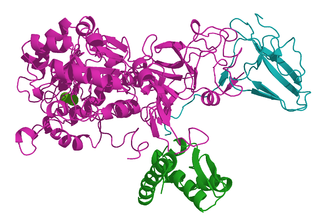Urea, also called carbamide, is an organic compound with chemical formula CO(NH2)2. This amide has two amino groups joined by a carbonyl functional group. It is thus the simplest amide of carbamic acid.

A fertilizer or fertiliser is any material of natural or synthetic origin that is applied to soil or to plant tissues to supply plant nutrients. Fertilizers may be distinct from liming materials or other non-nutrient soil amendments. Many sources of fertilizer exist, both natural and industrially produced. For most modern agricultural practices, fertilization focuses on three main macro nutrients: nitrogen (N), phosphorus (P), and potassium (K) with occasional addition of supplements like rock flour for micronutrients. Farmers apply these fertilizers in a variety of ways: through dry or pelletized or liquid application processes, using large agricultural equipment or hand-tool methods.

Ureases, functionally, belong to the superfamily of amidohydrolases and phosphotriesterases. Ureases are found in numerous bacteria, fungi, algae, plants, and some invertebrates, as well as in soils, as a soil enzyme. They are nickel-containing metalloenzymes of high molecular weight.
Urea-formaldehyde (UF), also known as urea-methanal, so named for its common synthesis pathway and overall structure, is a nontransparent thermosetting resin or polymer. It is produced from urea and formaldehyde. These resins are used in adhesives, plywood, particle board, medium-density fibreboard (MDF), and molded objects. In agriculture, urea-formaldehyde compounds are one of the most commonly used types of slow-release fertilizer.

The Dakin oxidation (or Dakin reaction) is an organic redox reaction in which an ortho- or para-hydroxylated phenyl aldehyde (2-hydroxybenzaldehyde or 4-hydroxybenzaldehyde) or ketone reacts with hydrogen peroxide (H2O2) in base to form a benzenediol and a carboxylate. Overall, the carbonyl group is oxidised, whereas the H2O2 is reduced.

(+)-CPCA is a stimulant drug similar in structure to pethidine and to RTI-31, but nocaine is lacking the two-carbon bridge of RTI-31's tropane skeleton. This compound was first developed as a substitute agent for cocaine.

Troparil is a stimulant drug used in scientific research. Troparil is a phenyltropane-based dopamine reuptake inhibitor (DRI) that is derived from methylecgonidine. Troparil is a few times more potent than cocaine as a dopamine reuptake inhibitor, but is less potent as a serotonin reuptake inhibitor, and has a duration spanning a few times longer, since the phenyl ring is directly connected to the tropane ring through a non-hydrolyzable carbon-carbon bond. The lack of an ester linkage removes the local anesthetic action from the drug, so troparil is a pure stimulant. This change in activity also makes troparil slightly less cardiotoxic than cocaine. The most commonly used form of troparil is the tartrate salt, but the hydrochloride and naphthalenedisulfonate salts are also available, as well as the free base.

A controlled-release fertiliser (CRF) is a granulated fertiliser that releases nutrients gradually into the soil. Controlled-release fertilizer is also known as controlled-availability fertilizer, delayed-release fertilizer, metered-release fertilizer, or slow-acting fertilizer. Usually CRF refers to nitrogen-based fertilizers. Slow- and controlled-release involve only 0.15% of the fertilizer market (1995).
Urea (46-0-0) accounts for more than fifty percent of the world's nitrogenous fertilizers. It is found in granular or prill form, which allows urea to be easily stored, transported and applied in agricultural settings. It is also the cheapest form of granular nitrogen fertilizer. Since urea is not an oxidizer at standard temperature and pressure, it is safer to handle and less of a security risk than other common nitrogen fertilizers, such as ammonium nitrate. However, if urea is applied to the soil surface, a meaningful fraction of applied fertilizer nitrogen may be lost to the atmosphere as ammonia gas; this only occurs under certain conditions.

Salicylhydroxamic acid is a drug that is a potent and irreversible enzyme inhibitor of the urease enzyme in various bacteria and plants; it is usually used for urinary tract infections. The molecule is similar to urea but is not hydrolyzable by urease; it thus disrupts the bacteria's metabolism through competitive inhibition. It is also a trypanocidal agent. When administered orally, it is metabolized to salicylamide, which exerts analgesic, antipyretic, and anti-inflammatory effects.

Arylcyclohexylamines, also known as arylcyclohexamines or arylcyclohexanamines, are a chemical class of pharmaceutical, designer, and experimental drugs.

Nitrapyrin is an organic compound with the formula ClC5H3NCCl3, and is described as a white crystalline solid with a sweet odor. It is used as a nitrification inhibitor and bactericide, which is applied to soils for the growing of agricultural crops since 1974. Nitrapyrin was put up for review by the EPA and deemed safe for use in 2005. Nitrapyrin is an effective nitrification inhibitor to the bacteria Nitrosomonas and has been shown to drastically the reduce the amount of N2O emissions from the soil.

Phosphoramides are a class of phosphorus compounds with the formula O=P(NR2)3-n(OH)n. They can be considered derivatives of phosphoric acid where OH groups have been replaced with an amino or R-substituted amino group. In practise the term is commonly confined to the phosphoric triamides (P(=O)(NR2)3), essentially phosphoramide and derivatives thereof. Derivatives with the general structures P(=O)(OH)(NR2)2 or P(=O)(OH)2(NR2) are usually referred to as phosphoramidic acids.

Dimethylcarbamoyl chloride (DMCC) is a reagent for transferring a dimethylcarbamoyl group to alcoholic or phenolic hydroxyl groups forming dimethyl carbamates, usually having pharmacological or pesticidal activities. Because of its high toxicity and its carcinogenic properties shown in animal experiments and presumably also in humans, dimethylcarbamoyl chloride can only be used under stringent safety precautions.

Acrylfentanyl (also known as acryloylfentanyl) is a highly potent opioid analgesic that is an analog of fentanyl and has been sold online as a designer drug. In animal studies the IC50 (the half maximal inhibitory concentration for acrylfentanyl to displace naloxone) is 1.4 nM, being slightly more potent than fentanyl itself (1.6 nM) as well as having a longer duration of action.

Diamidophosphate (DAP) is the simplest phosphorodiamidate ion, with formula PO2(NH2)2−. It is a phosphorylating ion and was first used for the phosphorylation of sugars in aqueous medium. DAP has attracted interest in the area of primordial chemistry.

Mozenavir (DMP-450) is an antiviral drug which was developed as a treatment for HIV/AIDS. It acts as an HIV protease inhibitor and binds to this target with high affinity, however despite promising results in early testing, mozenavir was unsuccessful in human clinical trials. Studies continue into related derivatives.

N-(n-Butyl)thiophosphoric triamide (NBPT) is the organophosphorus compound with the formula SP(NH2)2(NHC4H9). It is an amide of thiophosphoric acid. A white solid, NBPT is an "enhanced efficiency fertilizer", intended to limit the release of nitrogen-containing gases following fertilization. Regarding its chemical structure, the molecule features tetrahedral phosphorus bonded to sulfur and three amido groups.

Butafenacil is the ISO common name for an organic compound of the pyrimidinedione chemical class used as an herbicide. It acts by inhibiting the enzyme protoporphyrinogen oxidase to control broadleaf and some grass weeds in crops including cereals and canola.

















